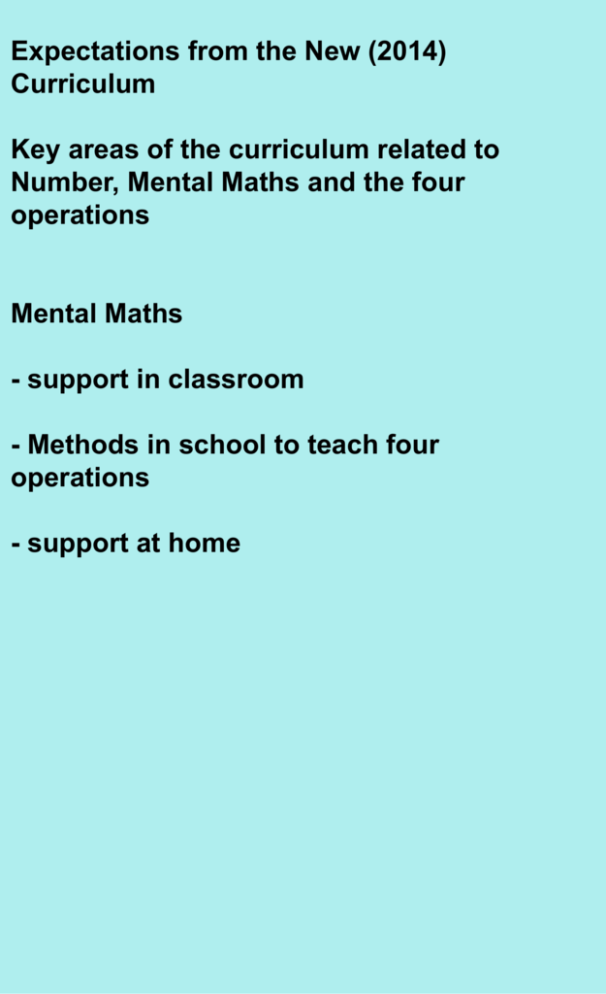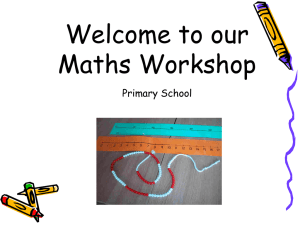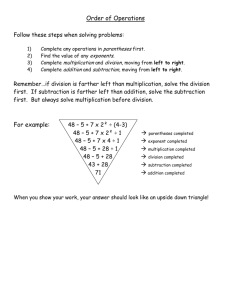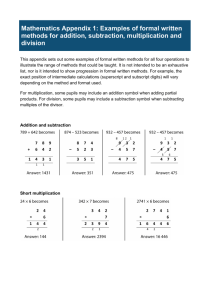Number – addition and subtraction
advertisement

Expectations from the New (2014) Curriculum Key areas of the curriculum related to Number, Mental Maths and the four operations Mental Maths - support in classroom - Methods in school to teach four operations - support at home Year 1 – programme of study Number and place value · count to and across 100, forwards and backwards, beginning with 0 or 1, or from any given number · given a number, identify one more and one less Number – addition and subtraction · read, write and interpret mathematical statements involving addition (+), subtraction (–) and equals (=) signs · represent and use number bonds and related subtraction facts within 20 · add and subtract one-digit and two-digit numbers to 20, including zero Year 2 – programme of study Number and place value ·count in steps of 2, 3, and 5 from 0, and in tens from any number, forward and backward Number – addition and subtraction ·recall and use addition and subtraction facts to 20 fluently, and derive and use related facts up to 100 ·add and subtract numbers using concrete objects, pictorial representations, and mentally, including: 1. a two-digit number and ones 2. a two-digit number and tens 3. two two-digit numbers 4. adding three one-digit numbers Number – multiplication and division ·recall and use multiplication and division facts for the 2, 5 and 10 multiplication tables, including recognising odd and even numbers Year 3 – programme of study Number and place value ·count from 0 in multiples of 4, 8, 50 and 100; find 10 or 100 more or less than a given number Number – addition and subtraction ·add and subtract numbers mentally, including: 1. a three-digit number and ones 2. a three-digit number and tens 3. a three-digit number and hundreds ·add and subtract numbers with up to three digits, using formal written methods of columnar addition and subtraction Number – multiplication and division ·recall and use multiplication and division facts for the 3, 4 and 8 multiplication tables ·write and calculate mathematical statements for multiplication and division using the multiplication tables that they know, including for two-digit numbers times one-digit numbers, using mental and progressing to formal written methods How do we support children with mental Maths and number? ·Opportunities to practise and learn number facts not just 'tested' ·Use of practical resources to support with mental Maths e.g. Numicon, beadstrings, 100 squares, number lines ·Daily mental maths section at the start of each session · Regular counting in class in different intervals ·Teaching conceptual understanding through 'Make it', 'Draw it', 'Say it', 'Write it' e.g. calculation 7 x 8 = ·Make it Make array with cubes or counters ·Draw it Draw the array circles or squares ·Say it - explain what the times symbol means ·Write it - write the calculation out - use a number line Activities with a Number line - count forwards and backwards in 1s, 2s, etc - pick one number, then another and count the difference between them (add and subtract). - choose a number - say one more/one less - two more/two less Can be used to find the difference by counting up from the smaller number to the Empty number line ·Start on any number large number ·Jump e.g.180 - 123 = 57 forwards/backwards 7 123 50 130 180 number ·Land on any number ·Can be use for addition, subtraction, multiplication and division ·"Friendly numbers" multiple of 10 Number square ·Count forwards and backwards in 2s, 5s and 10s ·Adding and subtracting 10 or multiples of 10 ·Pick a number in your head, point to 10 more or 10 less and child has to work out what the number is. 4 in a row: (a game for 2 or 3 players) Throw three 0 – 9 dice. Use the numbers and any operation to make one of the numbers on the hundred square. If all the players agree that the calculation is correct, cover the number with one of your counters. The aim is to get four of your counters in a row. Squares: Draw a 2 by 2 square on the hundred square. Add the numbers in opposite corners. What do you notice? Is it the same for different 2 by 2 squares? Now multiply the numbers in opposite corners. What do you notice this time? Is it always true? Consecutive numbers: Circle three numbers next to each other in a row. Find their total. Repeat for other groups of three consecutive numbers. What do all of the answers have in common? Try to explain why this happens. Strategies and Methods for the four operations Adding Use mental methods for all calculations unless for certain 3 digit numbers Partitioning the second number e.g. 67 + 25 = 67 + 20 = 87 87 + 5 = 92 Subtraction Partition the second number for take away e.g. 93 - 52 = 93 - 50 = 43 43 - 2 = 41 or 'find the difference' - 'counting up' using an empty number line (example on previous page) Multiplication and division Use of arrays 'Make it' 'Draw it' 'Say it' 'Write it' Counting the number - Count in 3s, 7 times e.g. 7 x 3 = 3, 6, 9, 12, 15, 18, 21 - using a number line to record 21 ÷ 3 = 7 Count on in 3s, 7 times 1 2 3 4 5 6 7 3, 6, 9, 12, 15, 18, 21, Activities to do at home to help with Maths Here are some suggested activities you could do with your child to help them with their Maths work in school. · Counting toys, books, cars, games as you get them out to play. Can you divide them into groups of 2, 3, 4, 5 or 10? Can you predict whether they can be divided up into groups of 2, 3, 4, 5 or 10? What did you use to help you with that prediction? · Counting cutlery, plates, cups etc when helping to lay the table. · Counting page numbers on the bottom corners of books – asking other questions such as How many more pages until the end? What fraction of the book have you read? · ‘Number spotting’. Look for numbers in the home, when shopping, walking and driving e.g. Reading ’12 miles to Cambridge’, door numbers on houses, numbers on packaging. When spotting numbers talk about which is smaller/bigger – ask How much is it smaller/bigger by? Focus on the difference between 13 and 30 (thirteen/thirty) as well as 21 – 12, 15 - 51 etc · When counting objects (books, plates) ask word problem type questions. E.g. There are 2 forks here and 3 forks there, how many is that altogether? There are 6 books on the shelf, if I take 3 off, how many will be left? Each person has 3 pieces of cutlery. How many pieces of cutlery would there be for 6 people? I have got 32 biscuits. How can these be divided between 8 people fairly? · Estimate how many toys/books there are. - What would be a good way of counting them? Could you group them in 2s, 3s, 4s, 5s and 10s? Now can you add them up by counting in 2s, 5s and 10s?





